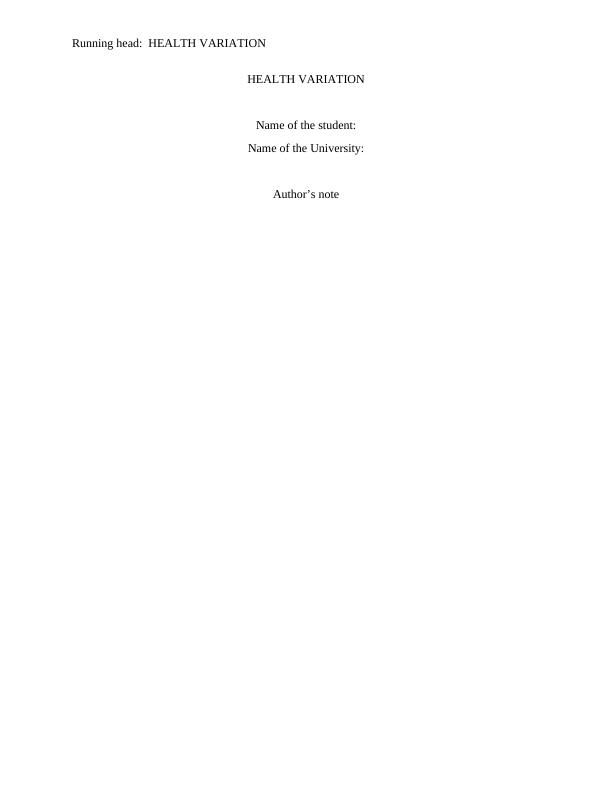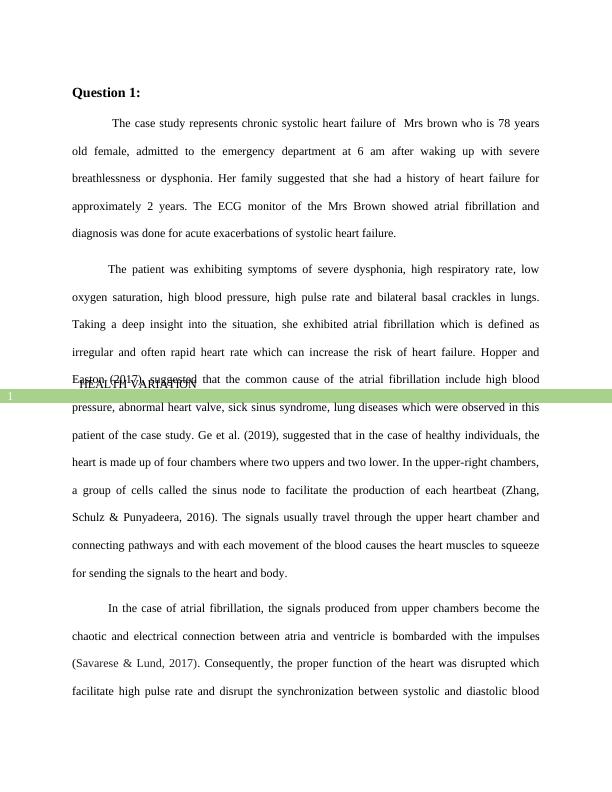Case study of chronic systolic heart failure of a diabetic female student
Added on 2022-10-15
10 Pages2559 Words207 Views
Running head: HEALTH VARIATION
HEALTH VARIATION
Name of the student:
Name of the University:
Author’s note
HEALTH VARIATION
Name of the student:
Name of the University:
Author’s note

HEALTH VARIATION
1
Question 1:
The case study represents chronic systolic heart failure of Mrs brown who is 78 years
old female, admitted to the emergency department at 6 am after waking up with severe
breathlessness or dysphonia. Her family suggested that she had a history of heart failure for
approximately 2 years. The ECG monitor of the Mrs Brown showed atrial fibrillation and
diagnosis was done for acute exacerbations of systolic heart failure.
The patient was exhibiting symptoms of severe dysphonia, high respiratory rate, low
oxygen saturation, high blood pressure, high pulse rate and bilateral basal crackles in lungs.
Taking a deep insight into the situation, she exhibited atrial fibrillation which is defined as
irregular and often rapid heart rate which can increase the risk of heart failure. Hopper and
Easton (2017), suggested that the common cause of the atrial fibrillation include high blood
pressure, abnormal heart valve, sick sinus syndrome, lung diseases which were observed in this
patient of the case study. Ge et al. (2019), suggested that in the case of healthy individuals, the
heart is made up of four chambers where two uppers and two lower. In the upper-right chambers,
a group of cells called the sinus node to facilitate the production of each heartbeat (Zhang,
Schulz & Punyadeera, 2016). The signals usually travel through the upper heart chamber and
connecting pathways and with each movement of the blood causes the heart muscles to squeeze
for sending the signals to the heart and body.
In the case of atrial fibrillation, the signals produced from upper chambers become the
chaotic and electrical connection between atria and ventricle is bombarded with the impulses
(Savarese & Lund, 2017). Consequently, the proper function of the heart was disrupted which
facilitate high pulse rate and disrupt the synchronization between systolic and diastolic blood
1
Question 1:
The case study represents chronic systolic heart failure of Mrs brown who is 78 years
old female, admitted to the emergency department at 6 am after waking up with severe
breathlessness or dysphonia. Her family suggested that she had a history of heart failure for
approximately 2 years. The ECG monitor of the Mrs Brown showed atrial fibrillation and
diagnosis was done for acute exacerbations of systolic heart failure.
The patient was exhibiting symptoms of severe dysphonia, high respiratory rate, low
oxygen saturation, high blood pressure, high pulse rate and bilateral basal crackles in lungs.
Taking a deep insight into the situation, she exhibited atrial fibrillation which is defined as
irregular and often rapid heart rate which can increase the risk of heart failure. Hopper and
Easton (2017), suggested that the common cause of the atrial fibrillation include high blood
pressure, abnormal heart valve, sick sinus syndrome, lung diseases which were observed in this
patient of the case study. Ge et al. (2019), suggested that in the case of healthy individuals, the
heart is made up of four chambers where two uppers and two lower. In the upper-right chambers,
a group of cells called the sinus node to facilitate the production of each heartbeat (Zhang,
Schulz & Punyadeera, 2016). The signals usually travel through the upper heart chamber and
connecting pathways and with each movement of the blood causes the heart muscles to squeeze
for sending the signals to the heart and body.
In the case of atrial fibrillation, the signals produced from upper chambers become the
chaotic and electrical connection between atria and ventricle is bombarded with the impulses
(Savarese & Lund, 2017). Consequently, the proper function of the heart was disrupted which
facilitate high pulse rate and disrupt the synchronization between systolic and diastolic blood

HEALTH VARIATION
2
pressure. In this current context, the heart can’t pump with enough force for pushing the blood
into circulation in each resting period between each heartbeat. The lack of proper function of the
cardiac muscles is associated with abnormal pulse rate as observed in this case study. In the case
of the healthy individuals, the normal pulse rate is 60 to 100 beats per minute whereas, in the
case of the patient, the pulse rate of the patient was 120 beats per minute (Kober et al., 2016).
The atrial fibrillation of the patient also increases the respiratory rate due to low oxygen
saturation in the blood as cardiac muscles failed to provide enough amount of oxygen in the
blood. In the case of healthy individuals, the normal respiratory rate for usually is between 12
and 20 breaths per minute (Prabhu et al., 2019). The breathing rate of below 12 or above 20
breathes indicate a disruption of breathing process as observed in this case study. In case of the
patient, the respiratory rate was 24 breaths per minute, indicating abnormal respiratory rate due
to the inability of providing enough oxygen to the heart (Sahle et al., 2016). On the hand, the
respiratory rate is usually high because of the low oxygen level in the blood. In case of normal
individuals, the oxygen saturation should be in between 94 percent to 100 percent which
indicates adequate oxygen supply in the blood (Andersen et al., 2016). However, in this case,
the patient had an oxygen saturation of 85 percent, indicating very low saturation in the blood
which further affects the normal function of the cardiac muscles. In this case, due to the low
oxygen level, the patient experienced severe breathlessness which is called dysphonia. The
dysphonia can be observed due to the permanent damage to the lungs of the patient (Andersen et
al., 2016). The case study highlighted that bilateral basal crackles were observed in the case of
the patient. Chew et al. (2016), suggested that it refers to the presence of basal crackles in both
lungs. The crackles the patient is observed because of the small airway and collapsed by the fluid
buildup in the lungs or lack of aeration. Hence, while the patient exhibited different symptoms of
2
pressure. In this current context, the heart can’t pump with enough force for pushing the blood
into circulation in each resting period between each heartbeat. The lack of proper function of the
cardiac muscles is associated with abnormal pulse rate as observed in this case study. In the case
of the healthy individuals, the normal pulse rate is 60 to 100 beats per minute whereas, in the
case of the patient, the pulse rate of the patient was 120 beats per minute (Kober et al., 2016).
The atrial fibrillation of the patient also increases the respiratory rate due to low oxygen
saturation in the blood as cardiac muscles failed to provide enough amount of oxygen in the
blood. In the case of healthy individuals, the normal respiratory rate for usually is between 12
and 20 breaths per minute (Prabhu et al., 2019). The breathing rate of below 12 or above 20
breathes indicate a disruption of breathing process as observed in this case study. In case of the
patient, the respiratory rate was 24 breaths per minute, indicating abnormal respiratory rate due
to the inability of providing enough oxygen to the heart (Sahle et al., 2016). On the hand, the
respiratory rate is usually high because of the low oxygen level in the blood. In case of normal
individuals, the oxygen saturation should be in between 94 percent to 100 percent which
indicates adequate oxygen supply in the blood (Andersen et al., 2016). However, in this case,
the patient had an oxygen saturation of 85 percent, indicating very low saturation in the blood
which further affects the normal function of the cardiac muscles. In this case, due to the low
oxygen level, the patient experienced severe breathlessness which is called dysphonia. The
dysphonia can be observed due to the permanent damage to the lungs of the patient (Andersen et
al., 2016). The case study highlighted that bilateral basal crackles were observed in the case of
the patient. Chew et al. (2016), suggested that it refers to the presence of basal crackles in both
lungs. The crackles the patient is observed because of the small airway and collapsed by the fluid
buildup in the lungs or lack of aeration. Hence, while the patient exhibited different symptoms of

End of preview
Want to access all the pages? Upload your documents or become a member.
Related Documents
Clinical Manifestation of Diseaselg...
|11
|2377
|23
Concept Map and Guided question responselg...
|1
|306
|83
Health Variation Question 2022lg...
|11
|2794
|16
Pathogenesis of Systolic Heart Failure - PDFlg...
|12
|1881
|16
Chronic Systolic Heart Failure: Causes, Symptoms, and Treatmentlg...
|8
|2001
|221
case study-GUIDED QUESTIONS & CONCEPT MAP-1500 wordslg...
|1
|283
|54
